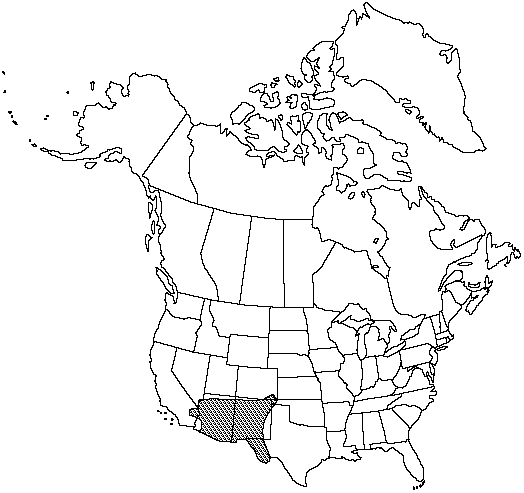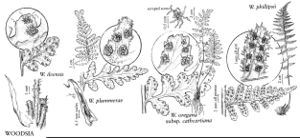Difference between revisions of "Woodsia plummerae"
Bot. Gaz. 7: 6. 1882.
FNA>Volume Importer |
FNA>Volume Importer |
||
| Line 26: | Line 26: | ||
}}<!-- | }}<!-- | ||
| − | --><span class="statement" id="st- | + | --><span class="statement" id="st-undefined" data-properties=""><b>Stems </b>compact, erect to ascending, with a few persistent petiole bases of unequal lengths; scales often uniformly brown but at least some bicolored with dark central stripe and pale brown margins, narrowly lanceolate. <b>Leaves</b> 5–25 × 1.5–6 cm. <b>Petiole</b> reddish brown to dark purple when mature, not articulate above base, somewhat pliable and resistant to shattering. <b>Blade</b> lanceolate to ovate, usually 2-pinnate proximally, densely glandular, often somewhat viscid; most glandular hairs with thick stalks and distinctly bulbous tips; rachis with abundant glandular hairs and a few narrow scales. <b>Pinnae</b> ovate-deltate to elliptic, longer than wide, abruptly tapered to a rounded or broadly acute apex, occasionally attenuate; largest pinnae with 5–11 pairs of pinnules; abaxial and adaxial surfaces glandular, lacking nonglandular hairs or scales. <b>Pinnules</b> dentate, often shallowly lobed; margins nonlustrous, thin, densely glandular, lacking cilia but with occasional 1–2-celled translucent projections. <b>Vein</b> tips slightly (if at all) enlarged, barely visible adaxially. <b>Indusia</b> of relatively broad segments; segments multiseriate for most of length, often divided and uniseriate distally, composed of ± isodiametric cells, often surpassing mature sporangia. <b>Spores</b> averaging 44–50 µm. <b>2n</b> = 152.</span><!-- |
-->{{Treatment/Body | -->{{Treatment/Body | ||
| + | |phenology=Sporulating late spring–fall. | ||
|habitat=Cliffs and rocky slopes, usually on granite or volcanic substrates | |habitat=Cliffs and rocky slopes, usually on granite or volcanic substrates | ||
|elevation=700–3100 m | |elevation=700–3100 m | ||
| Line 48: | Line 49: | ||
|basionyms= | |basionyms= | ||
|family=Dryopteridaceae | |family=Dryopteridaceae | ||
| + | |phenology=Sporulating late spring–fall. | ||
|habitat=Cliffs and rocky slopes, usually on granite or volcanic substrates | |habitat=Cliffs and rocky slopes, usually on granite or volcanic substrates | ||
|elevation=700–3100 m | |elevation=700–3100 m | ||
| Line 55: | Line 57: | ||
|publication year=1882 | |publication year=1882 | ||
|special status= | |special status= | ||
| − | |source xml=https://jpend@bitbucket.org/aafc-mbb/fna- | + | |source xml=https://jpend@bitbucket.org/aafc-mbb/fna-data-curation.git/src/9216fc802291cd3df363fd52122300479582ede7/coarse_grained_fna_xml/V2/V2_441.xml |
|genus=Woodsia | |genus=Woodsia | ||
|species=Woodsia plummerae | |species=Woodsia plummerae | ||
| − | |||
| − | |||
| − | |||
| − | |||
| − | |||
| − | |||
| − | |||
| − | |||
| − | |||
| − | |||
| − | |||
| − | |||
| − | |||
| − | |||
| − | |||
| − | |||
| − | |||
| − | |||
| − | |||
| − | |||
| − | |||
| − | |||
| − | |||
| − | |||
| − | |||
| − | |||
| − | |||
| − | |||
| − | |||
| − | |||
| − | |||
| − | |||
| − | |||
| − | |||
| − | |||
| − | |||
| − | |||
| − | |||
| − | |||
| − | |||
| − | |||
| − | |||
| − | |||
| − | |||
| − | |||
| − | |||
| − | |||
| − | |||
| − | |||
| − | |||
| − | |||
}}<!-- | }}<!-- | ||
-->[[Category:Treatment]][[Category:Woodsia]] | -->[[Category:Treatment]][[Category:Woodsia]] | ||
Revision as of 14:20, 27 July 2019
Stems compact, erect to ascending, with a few persistent petiole bases of unequal lengths; scales often uniformly brown but at least some bicolored with dark central stripe and pale brown margins, narrowly lanceolate. Leaves 5–25 × 1.5–6 cm. Petiole reddish brown to dark purple when mature, not articulate above base, somewhat pliable and resistant to shattering. Blade lanceolate to ovate, usually 2-pinnate proximally, densely glandular, often somewhat viscid; most glandular hairs with thick stalks and distinctly bulbous tips; rachis with abundant glandular hairs and a few narrow scales. Pinnae ovate-deltate to elliptic, longer than wide, abruptly tapered to a rounded or broadly acute apex, occasionally attenuate; largest pinnae with 5–11 pairs of pinnules; abaxial and adaxial surfaces glandular, lacking nonglandular hairs or scales. Pinnules dentate, often shallowly lobed; margins nonlustrous, thin, densely glandular, lacking cilia but with occasional 1–2-celled translucent projections. Vein tips slightly (if at all) enlarged, barely visible adaxially. Indusia of relatively broad segments; segments multiseriate for most of length, often divided and uniseriate distally, composed of ± isodiametric cells, often surpassing mature sporangia. Spores averaging 44–50 µm. 2n = 152.
Phenology: Sporulating late spring–fall.
Habitat: Cliffs and rocky slopes, usually on granite or volcanic substrates
Elevation: 700–3100 m
Distribution

Ariz., Calif., Colo., N.Mex., Okla., Tex., n Mexico.
Discussion
The origin and phylogenetic affinities of the tetraploid Woodsia plummerae have not been established with certainty. The hypothesis that it arose as a hybrid between the Mexican species W. mollis (Kaulfuss) J. Smith and W. mexicana Fée (D. F. M. Brown 1964; D. B. Lellinger 1985) seems untenable in light of recent chromosome studies indicating that the latter species is also tetraploid (M. D. Windham 1993). On the basis of sporophyte morphology and spore ornamentation, W. plummerae appears most closely related to the W. mexicana complex and W. oregana. In fact, W. oregana can be difficult to separate from W. plummerae in western New Mexico and northern Arizona. Intermediate plants occurring in this region may represent stable allotetraploids resulting from hybridization between the diploid progenitors of W. plummerae and W. oregana subsp. cathcartiana. Considering the available evidence, populations of W. plummerae in the United States probably originated through autopolyploidy from a recently discovered, but as yet unnamed, Mexican diploid of similar morphology. Woodsia plummerae occasionally hybridizes with W. phillipsii to produce sterile, morphologically intermediate triploids.
Selected References
None.
